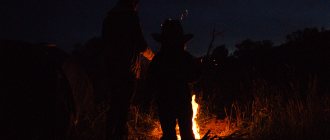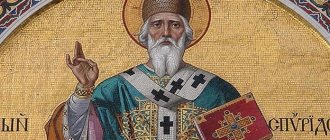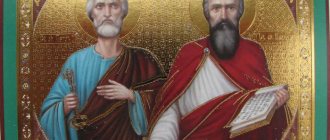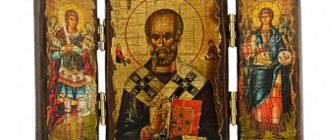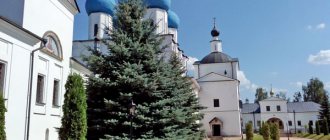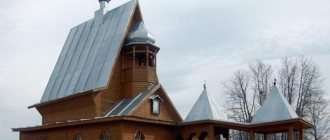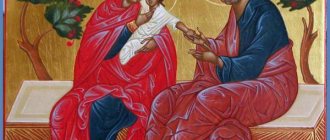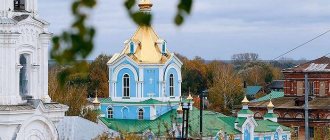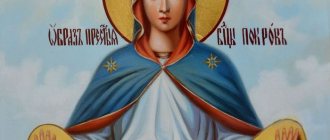"Save me, God!".
Thank you for visiting our website, before you start studying the information, please subscribe to our Orthodox community on Instagram, Lord, Save and Preserve † - https://www.instagram.com/spasi.gospodi/. The community has more than 60,000 subscribers. There are many of us like-minded people and we are growing quickly, we post prayers, sayings of saints, prayer requests, and timely post useful information about holidays and Orthodox events... Subscribe. Guardian Angel to you!
The Icon of the Exaltation of the Cross describes Queen Helena's finding of the Holy Cross on which Jesus Christ was crucified. After the Crucifixion, Resurrection and Ascension of the Lord, the instrument of torture of the Savior was lost. Queen Helena, the mother of Emperor Constantine the Great, managed to find him only in 326 after a grueling search.
Date of celebration of the Exaltation of the Life-Giving and Honorable Cross
The Feast of the Exaltation of the Life-Giving and Even Cross is a Holy Day for the Orthodox Church, celebrated by believers on September 27th. On this day, believers are given the opportunity to remember the miraculous finding of the Cross during the crucifixion of Jesus.
This holiday is considered the twelfth day, which is dedicated to Jesus, and is therefore called the Lord's Day.
The Feast of the Exaltation has deep significance in Christian destinies around the world. Due to the fact that the cross was given before the Feast of Holy Easter, its celebration fell on the second day of Easter.
This day is a celebration of two events:
- The discovery of the Cross near Mount Golgotha (in Jerusalem) in 326 at the site of the holy crucifixion.
- With the return of the Life-Giving Cross from Persian captivity in the 7th century, the holy banners were returned to Jerusalem by Heraclius, the Greek emperor.
The best article for you, go to: Icon of the Holy Martyr Galina, meaning and what it helps with
Christians celebrate the arrival of the holy day with strict fasting - they cannot eat food made from meat, fish, eggs or dairy products. It is recommended to use only vegetable oils – olive or sunflower – as a seasoning for food.
The Prayer of the Exaltation of the Holy Cross is short and sincere:
“I ask the incomprehensible and invincible Divine Power of the Honest and Life-giving Cross not to abandon us, sinners.”
Major holidays
Nativity. Novgorod. End of the 15th century Palazzo Leoni Montanari. Vicenza (Italy)
The prototype of the classical iconography of the Nativity of Christ, which we see in the icon reproduced here, is found on ampoules of the 5th and 6th centuries, in which pilgrims brought home oil from the lamps that burned in holy places from the Holy Land267.
In its descriptive part, the icon corresponds to the kontakion of the holiday: “Today the Virgin gives birth to the Most Essential and the earth brings a den to the Unapproachable; Angels and shepherds praise, while wolves travel with a star; For our sake, the Young Child, the Eternal God, was born.” The icon adds two more scenes, located in the lower corners, drawn from tradition.
In its content, the icon of the Nativity of Christ has two main aspects: first of all, it reveals the very essence of the event, the fact of the immutable incarnation of God, puts us before visible evidence of the main dogma of the Christian faith, emphasizing with its details both the Divinity and the humanity of the incarnate Word. Secondly, the icon of the Nativity of Christ shows us the effect of this event on the natural life of the world, giving us, as it were, a perspective of all its consequences. For, according to St. Gregory the Theologian, the Nativity of Christ is “not a feast of creation, but a feast of re-creation”268, a renewal that sanctifies the whole world. All creation, through the Incarnation of God, receives a new meaning of its existence, which lies in the ultimate goal of its existence - its future transformation. Therefore, all creation takes part in the event that has taken place, and around the born Infant of God we see representatives of the entire created world, each in his appropriate service, or, as the Church says, thanksgiving. “What shall we bring to You, Christ, since You appeared on earth as a Man for our sake? Every former creature from You brings thanksgiving to You: Angels - singing; heaven - a star; volsvi – gifts; shepherding is a miracle; earth is a den; desert - manger; we are the Virgin Mother…”269 To this the icon also adds offerings of the animal and plant worlds.
Nativity. Detail of a bone plate. VI century National Museum. London
The center of the icon, both semantic and compositional, with which all the details are somehow related, is the Child, wrapped in swaddling clothes, lying in a manger against the backdrop of the dark cave in which He was born270. In a word attributed to St. Gregory of Nyssa, there is a comparison of the Nativity of Christ in a cave with the spiritual radiance in the canopy of death that embraces humanity. The black hole of the cave in the icon, in its symbolic meaning, is this world, struck by sin through the fault of man, in which the “Sun of Truth” has shone.
The Gospel of Luke speaks about the manger and swaddling clothes (see: Luke 2:7): and he entwined Him, and laid Him in the manger, and further refers to the manger and swaddling clothes as a distinctive sign given by the angel, according to which the shepherds should recognize your Savior in the Child: And behold, this is a sign for you: you will find a Child’s midwife lying in a manger (Luke 2:12). The stichera tells us that the manger is an offering of the desert to the Infant God. The meaning of this offering is revealed by the words of St. Gregory the Theologian, who writes: “...bow down before the manger, through which you, having become wordless, are raised by the Word” (that is, you grow by eating the Eucharistic bread. - L.U.)271. The desert (in this case, an empty, uninhabited place), which provided shelter to the Savior, Whom the world did not accept from birth, was the fulfillment of the Old Testament prototype - the desert, in which the prototype of the Eucharist - manna - was revealed. He who rained down manna for the Jewish people - bread from heaven - Himself became the Eucharistic bread - the Lamb offered on the altar, the prototype of which is the manger offered as a gift to the Child in the desert of the New Testament.
Nativity. Detail of a sarcophagus. IV century
Basilica of Sant'Ambrogio. Milan
The cave, the manger, the shrouds are indications of the kenosis of the Divine, His exhaustion, the extreme humility of the One Who, invisible by nature, becomes visible to human flesh for the sake of being born in a cave, wrapped in shrouds, foreshadowing His death and burial, the coffin and burial shrouds.
In the cave right next to the manger there is an ox and a donkey. The Gospels do not mention them. And, however, in all images of the Nativity of Christ they are in close proximity to the Divine Infant. This place in the very center of the icon indicates the importance that the Church attaches to this detail. It is nothing other than the fulfillment of the prophecy of Isaiah, which has the deepest instructive meaning: The ox has known the covetous, and the donkey has known his master's manger: but Israel has not known Me, and My people have not understood (Is. 1:3). With the presence of animals, the icon recalls the prophecy of Isaiah and calls us to knowledge and understanding of the mystery of God’s Economy.
When looking at the icon of the Nativity of Christ, the first thing that attracts attention is the position of the Mother of God and the place that She occupies. In this “holiday of re-creation” She is “the renewal of all earthly beings,” the new Eve. Just as the first Evast became the mother of all living, so the new Evast became the Mother of all renewed humanity, deified through the incarnation of the Son of God.
She is the highest gratitude to God that man brings to the Creator among all creations. With this offering in the person of the Mother of God, fallen Humanity gives its consent to its salvation through the incarnation of God. The icon of the Nativity of Christ clearly emphasizes this role of the Mother of God, distinguishing Her from all other figures by its central location, and sometimes by its size. She reclines directly next to the Baby, on the bed, but usually already outside the cave. This bed is a kind of portable mattress or bedding that Jews carried with them when moving.
The pose of the Mother of God is always full of deep meaning and is directly related to dogmatic problems that arose in one era or another in one place or another. Its changes emphasize, depending on the need, either the Divinity or the humanity of the Savior. Thus, in some images She is half-sitting, which indicates the absence of Her usual sufferings and, therefore, the virginity of the Nativity and the divine origin of the Child (against Nestorian delusions). But in the overwhelming majority of images of the Nativity of Christ, the Mother of God lies, expressing in her pose great fatigue, which should remind those praying of the immutable humanity of the Child, “so that the incarnation would not be suspected of being illusory,” as Nikolai Mesarit says272.
Around the central group, the Infant God and His Mother, are located all the details that, as we have already said, testify to both the Incarnation itself and its effect on the entire created world.
Angels perform a twofold ministry: they praise and evangelize. On the icon this is usually expressed by the fact that some of them are turned upward and glorify God, others are inclined downward, towards the people to whom they proclaim the good news.
These people are shepherds. They are depicted listening to the angel's message, and often one of them plays the pipe, adding human art - music - to the angelic choir.
On the other side of the cave are the Magi, led by a star. They are depicted either riding, or, as in our icon, walking with gifts. The star points with a long beam directly at the cave. This ray connects the star with a part of the sphere extending beyond the icon - a symbolic image of the heavenly world. By this, the icon shows that this star is not only a cosmic phenomenon, but also a bearer of the message emanating from the heavenly world, the message that “the Heavenly One was born on earth.”
She is the light that, according to St. Leo the Great, was hidden from the Jews, but shone to the pagans. The Church sees in the shepherds, the first sons of Israel, who bowed to the Child, the firstfruits of the Jewish Church, and in the Magi - the “firstfruits of tongues” (Matins, ipakoi, tone 8) - the Church of the Gentiles. On the one hand, there are shepherds, simple, inexperienced people with whom the heavenly world comes into direct communication in their everyday working life, on the other hand, there are the Magi, people of science who must go a long way from knowing what is relative to knowing what is relative. which is absolute, through the subject they study. In the worship of the Magi, the Church testifies that it accepts and sanctifies every human science that comes to it, if only the relative light of extra-Christian revelation leads those who serve it to the worship of the absolute Light. Let us add that usually the Magi are depicted as people of different ages, which especially emphasizes that revelation is given regardless of age and life experience.
In the lower corner of the icon, two women bathe the Child. This scene is based on a tradition also conveyed by the apocryphal Gospels of Pseudo-Matthew and Pseudo-James. Two women are midwives whom Joseph brought to the Mother of God. This scene from everyday life clearly shows that the newborn Child is the same as any newborn, and is subject to the natural demands of human nature.
One more detail especially emphasizes that in the Nativity of Christ “the order of nature is overcome”: this is Joseph. He is not part of the central group of the Child and His Mother; he is not a father and is pointedly separated from her. In front of him, in the guise of a hunched old shepherd, stands the devil tempting him. On some icons he is depicted with small horns or a tail. The presence of the devil and his role as a tempter takes on a particularly deep meaning in connection with this “feast of re-creation.” This icon, based on tradition, also conveys the content of some liturgical texts that speak of Joseph’s doubts and the confusion of his soul. This state is expressed in the icon by his sorrowful pose and is emphasized by the black spot of the cave, against which Joseph is sometimes depicted. The tradition, also transmitted by the apocrypha, tells how the devil, tempting Joseph, told him that the Virgin Nativity was impossible, because it was contrary to the laws of nature. This argument, taking various forms, constantly returns, passing through the entire history of the Church. Many heresies are based on it. In the person of Joseph, the icon reveals not only his personal drama, but also the universal drama, the difficulty of accepting that which is “more than words and reason” - the Incarnation of God.
If on some icons the Mother of God is depicted looking at the Baby, “composing in her heart” verbs about Him, or directly in front of her at the outside world, then on others She looks at Joseph, as if expressing with Her gaze compassion for his condition. By this, the icon teaches a tolerant and compassionate attitude towards human unbelief and doubts.
Nativity. Yaroslavl. XVII century YAHM
The second icon reproduced here is a typical example of complex, multifaceted icons of the 17th century. It consists of 16 scenes different in both time and place of action, combined into one general composition. Since all these scenes are directly or indirectly related to the Nativity of Christ, they are distributed in such a way that one scene passes into another, due to which the image takes on the character of a continuous story, representing as a whole a complex Christmas icon.
At the top of the icon, in the middle, is the usual image of the Nativity of Christ with worshiping angels, shepherds (directly under the manger) and Joseph being tempted by the devil (under the scene of the washing of the Child). In the left corner of the viewer there are icons of the Magi traveling to worship the Savior, led by an angel holding a star in his hands273. Below them, in an architectural structure in the form of a gazebo, is the Mother of God sitting on a golden throne with the Child of God on her knees, to whom the visiting Magi bring gifts. On the other side of the icon, to the right of the Savior’s manger, is the appearance of an angel to the sleeping wise men with the command not to return to Herod (see: Matt. 2:12). Above this scene are the Magi leaving on another road. Below the scene of the worship of the Magi is the appearance of an angel to Joseph with the command to flee to Egypt (see: Matt. 2:13). On the opposite side is the flight to Egypt of the Mother of God with the Child and Joseph, accompanied by his son, the future apostle and first Bishop of Jerusalem, James. This scene is depicted against the background of an Egyptian temple, from the wall of which an idol falls, and represents the fulfillment of the prophecy of Isaiah: Behold, the Lord <...> will come to Egypt, and the things made with hands of Egypt will shake at His presence (Is. 19: 1)274. In the lower left corner of the icon is King Herod questioning the scribes and wise men who are holding books with prophecies about the birth of Christ in their hands (see: Matt. 2:4). Nearby is the beating of babies. In the middle of this scene are mothers looking for their children among many murdered babies, whose heads are depicted in several rows in the foreground.
Above this scene, on the left, against the backdrop of the city, is a group of weeping mothers : A voice in Rama is heard quickly, crying and sobbing and much crying: Rachel weeping for her children, and unwilling to be consoled, as they are not
(Matt. 2:18). Nearby is the righteous Elizabeth with the baby John in her arms, hiding in a mountain cleft from the warrior pursuing her: “Elizabeth, having taken up John, prayed for a stone, saying: receive the mother and child. The mountain welcomes the Forerunner...”275Next to it is a mother hiding a swaddled baby with a halo under a tree. Above this scene there is a microscopic inscription: “Nathanael lying under the fig tree.” Neither the service of the day nor the apocryphal gospels say anything that Nathanael, like St. John the Baptist, escaped death during the massacre of the infants. And yet, on complex icons starting from the 17th century. this scene is not uncommon. In addition, in the Greek Gospel of the 11th century, located in the National Library in Paris, there is an illustration to the first chapter of the Gospel of John276 telling about the meeting of Christ with Nathanael. The image conveys the moment of Christ’s conversation with Nathanael, who approaches Him, accompanied by Philip, who called him (see: John 1:45-50), and behind, at some distance, under a tree stands the youth Nathanael with a halo. It is possible that the images of both the Greek manuscript and Russian icons are based on the mysterious phrase of St. John Chrysostom from his interpretation of this passage of the Gospel of John: “He knew Nathanael’s good behavior before, not as a man who followed him, but as God,” and further: “What then? Did Christ really see Nathanael only before Philip invited him, and until that time did not see him with his vigilant eye? I saw it, and no one will contradict this.”277 Based on these words of St. John Chrysostom, and also based on the fact that in some images Nathanael is represented as a baby, and in others as a youth, it can be assumed that in the Gospel expression “under the fig tree” one should understand Nathanael’s entire life. In this case, his image on the icon of the Nativity of Christ emphasizes the Divinity of the Savior. But it is possible, of course, that these images are based on a text unknown to us, which was used by ancient icon painters.
In the lower right corner of the icon from the viewer is the murder of St. Zechariah between the temple and the altar (Matt. 23:35). This scene, based on the words of the Savior, is explained in the Chetye Menaion on December 29, where the meaning of its presence in the icon of the Nativity of Christ is revealed: “Also St. You ordered the death of the prophet Zechariah for this, as the Most Pure Virgin, who entered the church for the sake of purification with the Child, put in the place of the maidens, but it is not fitting for wives who have husbands to stand in it...”278 in other words, St. Zechariah was killed by the scribes and Pharisees, and the reason for the murder was the virgin birth and Zechariah's prophetic insight into the Divinity of Christ.
But there is another, apocryphal version of this event in the “Proto-Gospel of James” (Chapter 23), according to which St. Zechariah was killed by order of Herod for not revealing to his servants the place of refuge of the infant John the Baptist, whom Herod mistook for the born King of the Jews. In this case, Zechariah was killed during the massacre of the infants and suffered with them for the born Savior of the world.
In an artistic sense, our icon is a very good example of complex icons of the 17th century.279 However, the narrative moment captivates the icon painter so much that the main event, overgrown with secondary subjects, to which he attaches equally important importance, is completely lost in them, fades into the background (cf . with the icon of the Nativity. Novgorod. End of the 15th century. Palazzo Leoni Montanari. Vicenza (Italy)
. The master clearly avoids open unfilled space, and all the multitude of details turns out to be devoid of compositional unity. And yet this icon has some great spiritual warmth. Despite the small writing, there is no pettiness of lines. There is also no dryness in it, characteristic of similarly complex icons of this and also of later times. It is written freely, with generalized colorful spots that are distributed with great artistic taste. The dominant tones are cinnabar and dark blue-greenish. There is a lot of gold, which, together with cinnabar and reddish earth, gives the icon a warm overall tone.
The meaning of the image of the Exaltation of the Cross
Russian icon painters provided the most common subject for the Exaltation icon to churches in the 15th century. On the holy canvas you can see a large crowd of people against the backdrop of a single-domed temple. on the pulpit you can see the Patriarch with the Cross raised above his head. In the foreground of the icon you can see the saints and all the believers. On the right you can see Queen Helena with Tsar Constantine.
The Icon of the Exaltation of the Honest and Life-Giving Cross of the Lord can be seen in:
- Alufevsky Temple of the Exaltation of the Holy Cross
- Moscow Church of the Exaltation of the Holy Cross on Chisty Vrazhek
- Vatican – in the Ecclesiastical State you can see the Miniature Menology of Emperor Basil II, written in the 11th century.
- Roman monastery complex of Santi Quattro Coronati - in the 13th century Chapel of San Silvestro you can see a canvas depicting the discovery of the Life-Giving Cross by Queen Helena.
The best article for you, go to: Icon and prayer - The Forty Martyrs of Sebaste, what they help with
Iconography
In the center of the composition rises the Cross, which Orthodox Christians associate with Jesus Christ himself and reminiscent of His suffering. But each of us understands that without His martyrdom the Resurrection would not have happened, there would be no Salvation.
The icon depicts many people - these are residents of Palestine, clergy, and in the distance stands Queen Helen with her son Emperor Constantine. The patriarch stands on a dais, in his hands he holds a cross decorated with green branches, which symbolizes the victory of life over death.
Exaltation of the Cross of the Lord icon - what it helps with
The Icon of the Exaltation of the Cross is known for its miraculous abilities. After a sincere prayer to the Holy Cross, a seriously ill woman managed to go on a full path to recovery from her illness.
In 2012, an electrician who came from Roslavl had severely inflamed gums. Both night and day, the unfortunate man could not find peace for himself and carry out the work assigned to him. He did not consider himself a church person, and the icon itself was of little interest to him. He was asked to take an unquenchable lamp, anoint his mouth with oil and ask the icon for healing.
With deep faith in his cure, the electrician did what was specified - and the disease receded. The next morning, he was on his knees with tears reading a prayer before the miraculous image.
The icon of the Exaltation helps in sincere prayers; they are said in front of the image so that:
- Coping with infertility.
- Get rid of incurable diseases.
- Heal diseased bones and joints.
- Coping with chronic migraines.
- Cure toothache.
The Icon of the Exaltation of the Cross of the Lord is a reflection of the discovery of the Holy Cross by Queen Helena. This holy cloth helps the needy to recover even from chronic or incurable diseases.
The best article for you, go to: Icon “Healer” of the Mother of God, meaning and what it helps with
God bless you!
Prayers
First prayer:
Be the Honest Cross, guardian of soul and body: in your image, casting down demons, driving away enemies, exercising passions and bestowing reverence, life, and strength, with the assistance of the Holy Spirit and the honest prayers of the Most Pure Mother of God. Amen.
Second prayer:
O Most Honest and Life-Giving Cross of the Lord! In ancient times you were a shameful instrument of execution, but now you are a sign of our salvation, ever revered and glorified! How worthily can I, the unworthy, sing to You and how dare I bend the knees of my heart before my Redeemer, confessing my sins! But the mercy and ineffable love for mankind of the humble Boldness crucified upon you gives me, so that I may open my mouth to glorify You; For this reason I cry to Ti: Rejoice, Cross, the Church of Christ is the beauty and foundation, the whole universe is the affirmation, all Christians are the hope, kings are the power, the faithful are refuge, Angels are glory and praise, demons are fear, destruction and driving away, the wicked and infidels - shame, the righteous - delight, the burdened - weakness, the overwhelmed - refuge, the lost - a mentor, those possessed by passions - repentance, the poor - enrichment, those floating - the helmsman, the weak - strength, in battle - victory and conquest, the orphans - faithful protection, widows - intercessor, virgins - protection of chastity, hopeless - hope, sick - a doctor and the dead - resurrection! You, typified by the miraculous rod of Moses, are a life-giving source, watering those thirsty for spiritual life and delighting our sorrows; You are the bed on which the Risen Conqueror of Hell rested royally for three days. For this reason, morning, evening, and noon, I glorify Thee, blessed Tree, and I pray by the will of the One who has been crucified on Thee, may He enlighten and strengthen my mind with You, may He open in my heart a source of more perfect love, and may all my deeds and paths be overshadowed by You. May I take out and magnify Him who is Nailed to You, for my sin, the Lord my Savior. Amen.
Tags: meaning , prayer , helps , photo , Lord , exaltation , cross , icon
